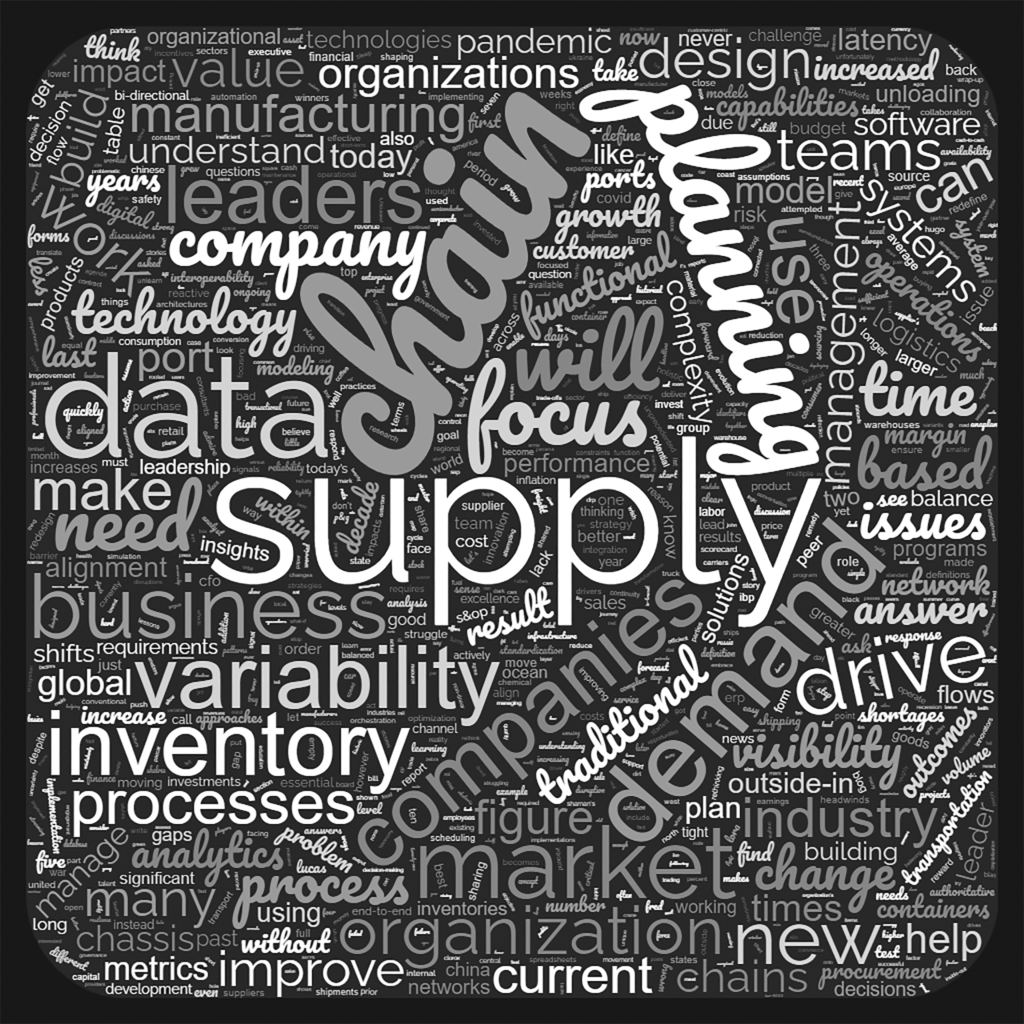I hopped on the plane in Baltimore on my way to Atlanta last week. Always late, I squeezed past a middle-aged man wearing a black mask in the aisle seat and promptly fell asleep nodding my head on the window ledge. As we circled Atlanta, I woke up and started a obligatory conversation with my neighbor. I started with, “Tell me about you. What brings you to Atlanta?” He replied, “You probably don’t know much about supply chain, but I am leading a supply chain team for a company that sells tools to Home Depot. I have to race to a call when the plane lands to join a conference call.”
I smiled, and responded, “I know a little about supply chain. How are things going for you? I know it is a tough environment.” He took off his mask, and sighed, “Supply chains are tougher to manage today than during the pandemic. My lead times increased from China from 93 to 210 days, and I am not able to properly plan.”
At this point, I fessed up and shared my background, and asked, “How can I help?” He replied that the company was in the middle of a RFP process to select a technology partner, and that he recently met with his current technology provider and their sister company, and was unimpressed. I asked him to describe his business and what they were looking for. As he spoke, I discovered:
- The Company Was Blindly Fielding RFP Process. The worst thing that a company can do in the selection of a planning technology is to field a RFP. The reason? Most RFPs are written with limited market insight and are biased to the leader’s world view. What should be done? Identify the goals, and set up exploratory meetings with a short-list of technology providers. Hire a consultant to help. Define the current state. Analyze the Coefficient of Variation (COV) at different points in the demand hierarchy to understand forecastability, and analyze the bias, FVA and latency of the current plan. Build a planning master data base to understand current leadtimes, conversion rates and currency fluctuations and analyze the impact of variability on reliability.
- He Was Unaware of What Makes a Good Plan. He could not answer the question of “What makes a good plan? (The answer to this question should always proceed a RFP.) Next steps? I asked him to think hard about, makes a good plan? And, what is required for modeling? This leader’s prior experience was in consumer products. In his new position, 80% of the items were new each season. As a result, his SKU-based logic paradigm needed to be shifted to embrace attribute and attach-rate planning. These modeling concepts were new to him. He was also unaware of how to measure Forecast Value-Added, the Bullwhip impact and the health of inventory. I quickly wrote a “how to guide” on a scrap piece of paper, suggested some consultants to help him with the analysis, and sent him home to define “what makes a good plan.” I then told him to define a pilot for testing and explained the concepts of backcasting, market-driven forecasting and demand translation. We discussed how to do this testing.
- Buzzword Bingo Does Not Ease the Pain. He ended the conversation by thanking me, and explaining, “That he was glad that he was able to now think more clearly.” He was using the Gartner Magic Quadrant as a handbook, but did not realize that this framework is devoid of information on fit of the models by industry sector, or size of company. As he talked, terms like control tower, concurrent and autonomous planning rolled off his tongue without clear definitions. Next step? Analyze the gaps of the prior year and define the planning taxonomy and design the optimization models to close the gap. Avoid buzzword bingo.
After our short discussion, he was probably glad to land. I feared that my feedback was a bit like a fire hose– spouting intense information in a brief period of time.
I did share with him the story of the pilot work in process for my upcoming conference. In the pilots, both companies have a negative Forecast Value Added (FVA). Neither company tested the planning engines in the installation, and the models chosen did not fit the business process.
When the model definitions were aligned to the process definitions, standard technology approaches improved the FVA by 2-7%.
Market-driven approaches improved accuracy and decreased latency. The use of market data doubled and tripled the accuracy, while cutting the time to sense market conditions by 70-80%. (I find that most supply chain leaders lack the understanding of model types and how to move from an error minimization perspective to maximize FVA and minimize demand latency.) This is change management at its finest. Which leads me to a big SIGH.
Why Do I Tell You This Story?
The essence of the story with the stranger on the Delta flight to Atlanta is what I see one-to-two times a week in my work with clients. Companies and consultants chase shiny objects without clarity on the road they are traveling. As a result, a lot of money is spent, but the company does not achieve the business results. (They usually blame the technology vendors or consultants without stepping back and analyzing what is needed.)
I find companies blindly chase shiny objects without stepping back and asking themselves basic questions:
- What makes a good plan?
- How can the implementation of planning technologies improve decision-making? What does this mean for governance and the design of work?
- How many supply chains are managed and what is the best fit of models for each?
- With the focus on reliablity, how can business leaders not only understand the shifts in the planning parameters of lead time, conversion rates, and currency, but also track variability and include it in the design of inventory buffers.
- What is the role of the forecast, budget, market data, and inventory in the proposed project?
- Do executives in the company have a common vision on the role of planning and the use of technology?
For this let’s have a collective industry SIGH! I hope this blog helps.
Have a great week! The oppressive heatwave is passing in Pennsylvania. I am ready for fall.
Ten Years a Blogger
Ten years ago, one of my favorite clients, Joe, challenged me to make the research more accessible, which led me to compile the blog posts annually into an e-book. (He was bothered that he had to dig for old blogs on the site.) This is post is 502 in a series started in 2012.

This week, I published my 10th Shaman’s Journal. The Journal is a compilation of best-read blog posts from the prior year. I share it here on Flipping Book (an e-book format viewer). I also print a small print run and sign them at the Supply Chain Insights Global Summit. (I usually have a few leftovers if you want a hard copy.)
To help potential readers understand the content, I stuffed the print-ready file into a word cloud engine this morning.

If you enjoy our research, please help us by filling out our current survey. We have a week left to get enough respondents to unveil the new results at the Supply Chain Insights Global Summit.
Enjoy! Access the prior journals on the Supply Chain Insights Global website. I welcome your feedback. Attendees at the Supply Chain Insights Global Summit will also get a book of my favorite case studies from the past decade. Will we see you there? The conference has both an online and an in-person event designed for extreme networking.
See You At the Supply Chain Insights Global Summit?

Registrations are pouring in for the Supply Chain Insights Global Summit on September 6th-8th in Washington, DC. The focus of the conference is on Supply Chain 2030. This conference has a physical presence for 90-100 business leaders at the Westin near Dulles Airport and a virtual component that Sarah Barnes Humphrey will facilitate on a collaborative platform.
In both formats, we design the conference for extreme networking. We aim to build a guiding coalition of industry leaders to drive change. We need to redefine supply chain planning architectures, but it needs to start with redesigning work. To do this, we must have a different discussion and free ourselves from conventional thinking. Here are five reasons to attend:
- Jump Start Your Learning on the Art of the Possible and New Forms of Analytics. The event is designed for extreme networking. In both the online and in-person format, you will engage with others by learning from case studies of hand-picked speakers, sharing research-based content, fun activities, facilitated networking, and structured activities.
- Imagine Supply Chain 2030. Challenge yourself to imagine the future in an environment where technology innovators and business leaders are equals. The event has no sponsorships and no technologist or consultant sales teams. Instead, it is designed as a learning environment, the event is designed as a place where leaders learn from leaders in a structured and safe environment.
- Supply Chains to Admire. Only 4% of public companies outperformed their peer group over the last decade. At the conference, hear from five Supply Chains to Admire Award winners and brainstorm on lessons learned.
- Learn from the Past to Unlearn. In the last decade, supply chain performance declined. All companies were challenged by the pandemic. In this session, gain insights on how we better align organizations and build outside-in processes.
- Build Teams. The question is, how do we drive next-generation talent? Learn from an industry leader case study and a panel of educators.
The virtual event is hosted by Sarah Barnes-Humphrey of Let’s Talk Supply Chain. The online conference is packed full of activities and networking opportunities. Sign-up your team now to get the prep materials in the countdown to the event.
The in-person event will be at the Westin at Dulles Airport. Attendees at the in-person event will Imagine Supply Chain 2030 through a series of structured activities with learnings captured by a visual artist. The dreams will take flight in a visit to the Smithsonian Air & Space Museum in a special tour for the group.







